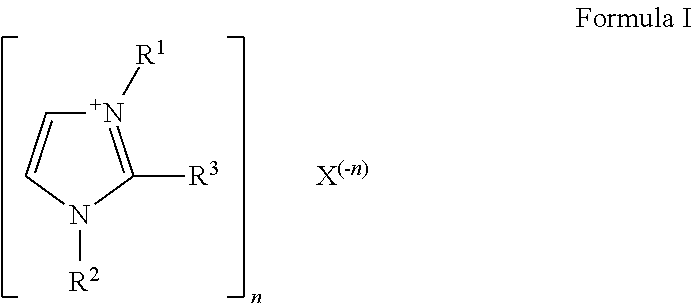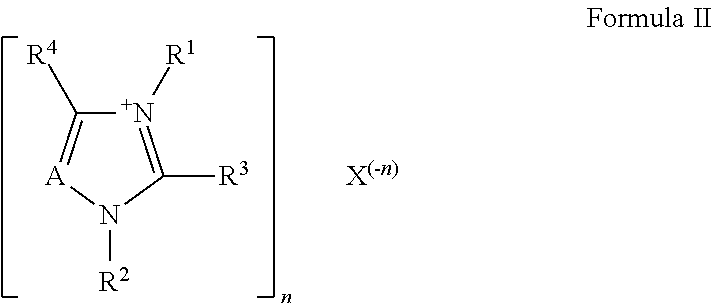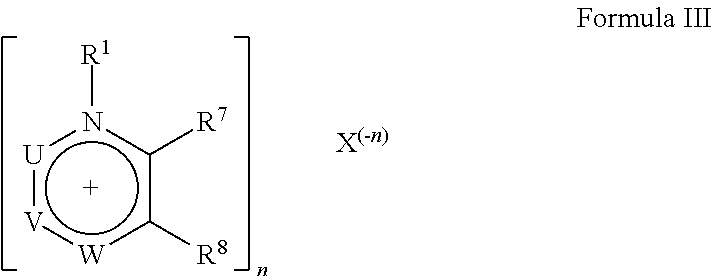Ionic liquid-solid-polymer mixed matrix membranes for gas separations
a technology of mixed matrix membrane and ionic liquid, which is applied in the direction of inorganic chemistry, chemical/physical processes, alkali metal oxides/hydroxides, etc., can solve the problems of insufficient durability and retention of ionic liquid, insufficient durability of ionic liquid, and inorganic membranes, etc., to achieve good solubility, easy processability, and high chemical and thermal stability
- Summary
- Abstract
- Description
- Claims
- Application Information
AI Technical Summary
Benefits of technology
Problems solved by technology
Method used
Image
Examples
example 1
Preparation of 6%[bmin][Tf2N]-20% PIM1-Matrimid Mixed Matrix Membrane
[0042]6%[bmin][Tf2N]-20% PIM1-Matrimid mixed matrix membrane was prepared by solution casting a polymer solution containing dispersed 1-butyl-3-methyl imidazolium bis(trifluormethylsulfonyl)imide ([bmin][Tf2N])-impregnated PIM1 fillers ([bmin][Tf2N] / Matrimid=6% by weight and PIM1 / Matrimid=20% by weight). 0.7 gram of Matrimid 5218 polymer was dissolved in 20 grams of CH2Cl2 solvent by stirring at room temperature to form a polymer solution (Solution A). 0.14 gram of PIM1 polymer synthesized as described in the literature (see McKeown, et al., CHEM. COMMUN., 2004, 230) was dissolved in 10 gram of CH2Cl2 solvent to form a Solution B, then 0.042 gram of [bmin][Tf2N] synthesized as described in the literature (see Bonhôte, et al., Inorg. Chem., 1996, 35, 1168) was added to Solution B. The resulting Solution B was stirred and ultrasonicated to remove the bubbles from the micropores of PIM1 and to ensure the impregnation ...
example 2
Preparation of 9%[bmim][Tf2N]-30% MCM-41-Ultem Mixed Matrix Membrane
[0044]9%[bmim][Tf2N]-30% MCM-41-Ultem mixed matrix membrane was prepared by solution casting a polymer solution containing dispersed [bmim][Tf2N]-impregnated MCM-41 fillers ([bmim][Tf2N] / Ultem=9% by weight and MCM-41 / Ultem=30% by weight). 0.7 gram of Ultem polyetherimide polymer was dissolved in 20 grams of CH2Cl2 solvent by stirring at room temperature to form a polymer solution (Solution A). 0.21 gram of MCM-41 mesoporous silica was dispersed in 10 grams of CH2Cl2 solvent to form a Slurry B, then 0.063 g of [bmim][Tf2N] was added to Slurry B. The resulting Slurry B was stirred and ultrasonicated to remove the bubbles from the mesopores of MCM-41 and to ensure the impregnation of C4mimTf2N into the mesopores of MCM-41. Then, the CH2Cl2 solvent was removed from Slurry B under reduced pressure to obtain [bmim][Tf2N]-impregnated MCM-41 fillers. The [bmim][Tf2N]-impregnated MCM-41 fillers were then added to Solution A,...
example 3
Preparation of 9%[bmim][Tf2N]-30% Carbon Molecular Sieve-Ultem Mixed Matrix Membrane
[0045]9%[bmim][Tf2N]-30% carbon molecular sieve-Ultem mixed matrix membrane was prepared by solution casting a polymer solution containing dispersed [bmim][Tf2N]-impregnated carbon molecular sieve fillers ([bmim][Tf2N] / Ultem=9% by weight and carbon molecular sieve / Ultem=30% by weight). 0.7 g of Ultem polyetherimide polymer was dissolved in 20 g of CH2Cl2 solvent by stirring at room temperature to form a polymer solution (Solution A). 0.21 g of carbon molecular sieve was dispersed in 10 g of CH2Cl2 solvent to form a Slurry B, then 0.063 g of [bmim][Tf2N] was added to Slurry B. The resulting Slurry B was stirred and ultrasonicated to remove the bubbles from the micro- and meso-pores of carbon molecular sieve and to ensure the impregnation of [bmim][Tf2N] into the micro- and meso-pores of carbon molecular sieve. Then, the CH2Cl2 solvent was removed from Slurry B under reduced pressure to obtain [bmim][T...
PUM
| Property | Measurement | Unit |
|---|---|---|
| Temperature | aaaaa | aaaaa |
| Pressure | aaaaa | aaaaa |
| Pressure | aaaaa | aaaaa |
Abstract
Description
Claims
Application Information
 Login to View More
Login to View More - R&D
- Intellectual Property
- Life Sciences
- Materials
- Tech Scout
- Unparalleled Data Quality
- Higher Quality Content
- 60% Fewer Hallucinations
Browse by: Latest US Patents, China's latest patents, Technical Efficacy Thesaurus, Application Domain, Technology Topic, Popular Technical Reports.
© 2025 PatSnap. All rights reserved.Legal|Privacy policy|Modern Slavery Act Transparency Statement|Sitemap|About US| Contact US: help@patsnap.com



